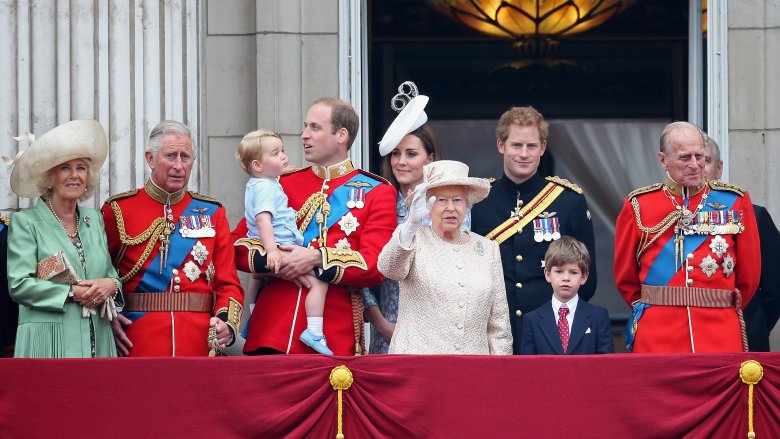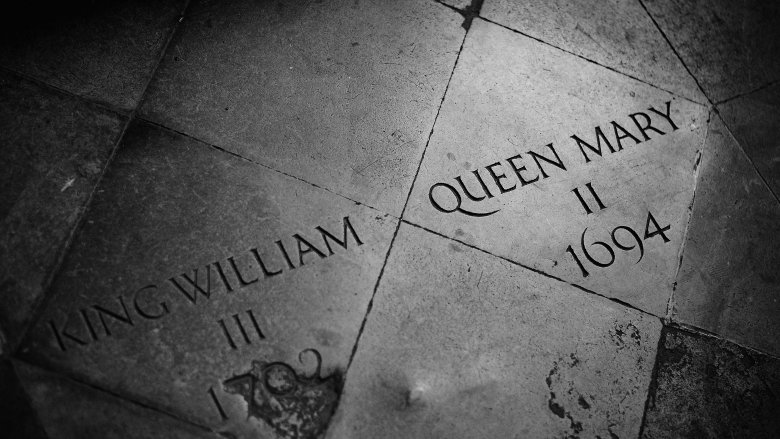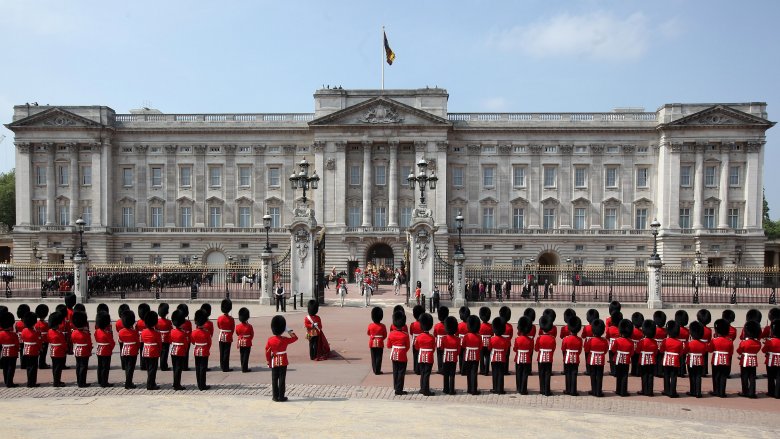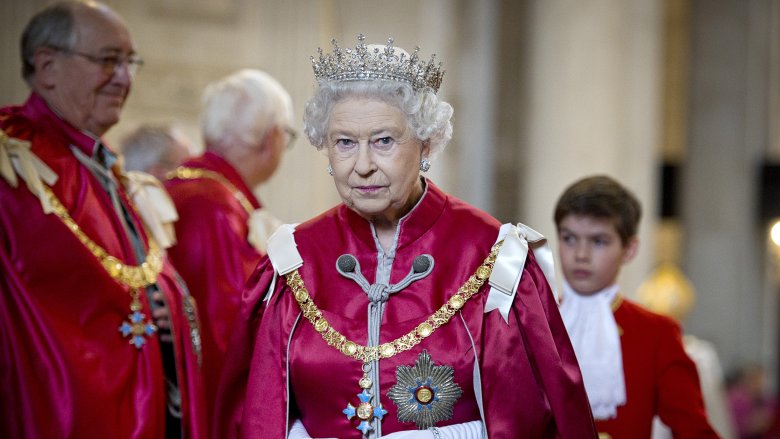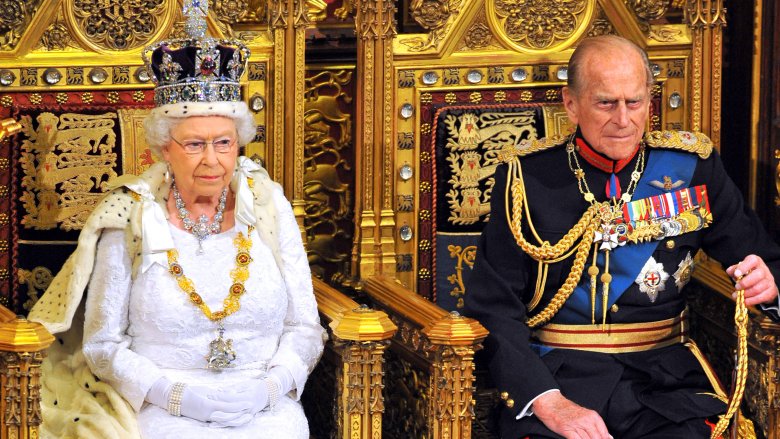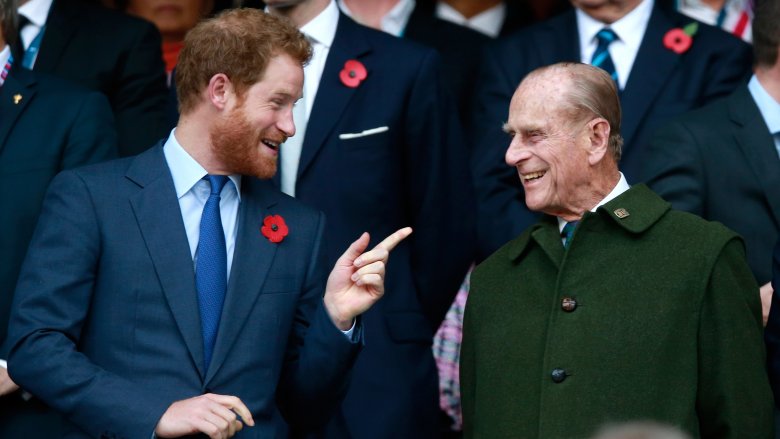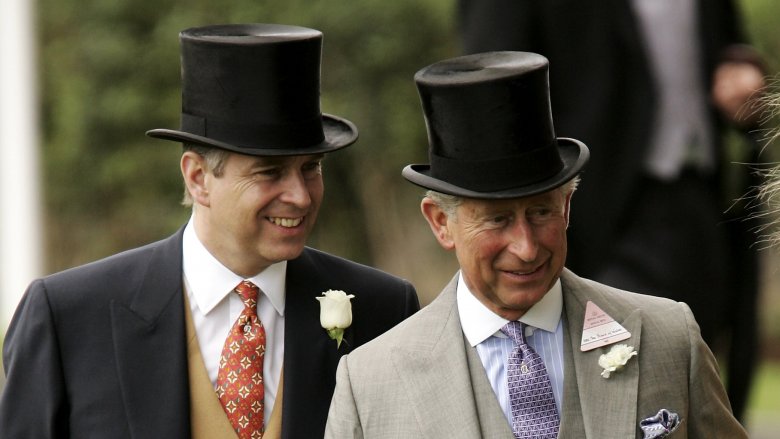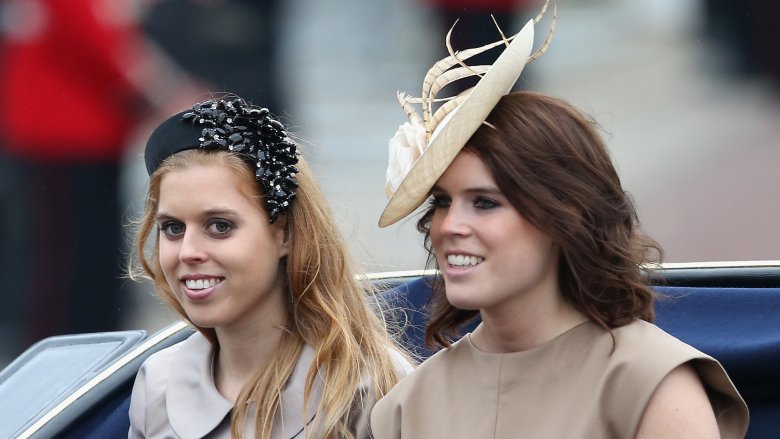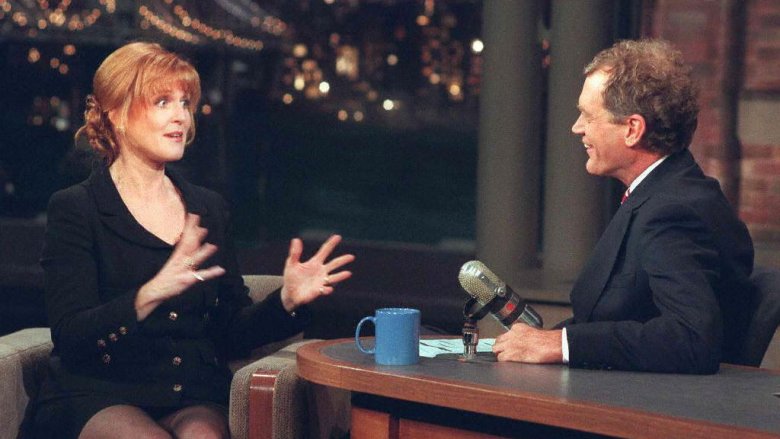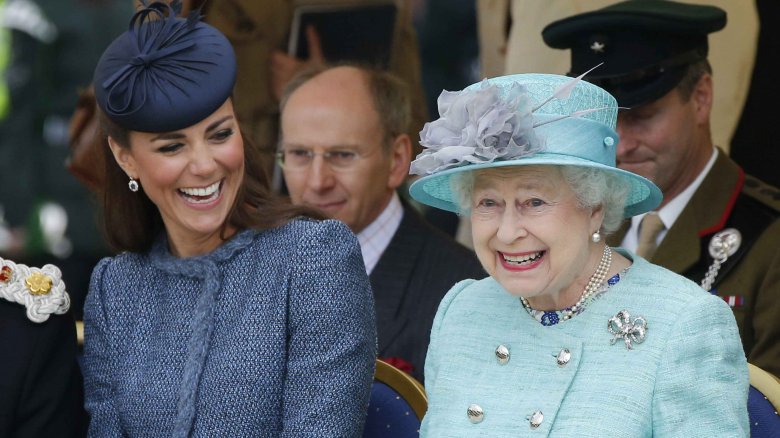How The Royal Family Really Makes Its Money
It seems like only yesterday that Britain's most iconic landmarks were being set aglow with pink to celebrate the birth of Princess Charlotte, but fans of the British Royal Family have since welcomed a third royal baby for the Duke and Duchess of Cambridge into the world. Prince William and his wife Kate Middleton are spearheading a new era of popularity for the House of Windsor, yet keeping that house in working order isn't exactly cheap. The upkeep of royal palaces and the cost of the many visits the royal family make every year has to be paid for somehow, and the Queen herself isn't as wealthy as you might assume — in 2015 she slipped out of the list of the top 300 richest people in Britain for the first time ever.
Her Majesty has fallen further down the pecking order in the two years since, named at number 329 on the The Sunday Times 2017 rich list. Of course, this doesn't exactly make Elizabeth II a pauper (she still has a net worth of an estimated $475 million), but living in a time when the head of state's power is pretty much just symbolic means she's had to tighten the purse strings somewhat. So where do they get their cash? Does the Queen doll out pocket money, or do the royals earn their own keep? This is how the royal family really makes its money.
The Civil List
The royals have a history of financial misappropriation, even after the introduction of the Civil List in the 17th century. Before this point the monarchy made its money through hereditary revenue and mass taxation, but during the reign of William III (1650-1702) things changed. He and his wife Mary II were the first to suggest that the cost of keeping the Crown should be separate from that of funding the government, which led to the Civil List Act being passed. This put caps on how much kings and queens could make, with any surplus going straight to parliament, but those income caps were repeatedly ignored by British rulers over the years that followed.
According to The Guardian, Queen Anne overspent by $1.6 million during her reign (1702-1714), George I stacked up debts of $1.7 million while on the throne (1714-1727), while King George III (1738-1820) spent more than $1.5 million that he shouldn't have. All of these debts were covered by parliament, who were used to bailing out spend-happy monarchs at this point. Even the reigning Queen Elizabeth II has had her own share of controversy regarding the Civil List funds.
The idea of extended family members benefiting from the Civil List is a relatively recent one, and it has never been popular among the masses. In 1981 The Queen caved into public/parliamentary opinion and agreed to having three of her cousins stricken from the list. She refunded the exchequer what they'd been paid according to the BBC.
The Sovereign Grant
In 2011, with public opinion on royal expenses still at a low ebb in Britain, a new system of funding the lifestyle of the royal family was devised. The Civil List was given the axe, and in its place the Sovereign Grant Act was passed. This meant that the Crown would now be funded by revenue the government collects from The Crown Estate, a stunning portfolio of properties dating back to 1066 and the Norman Conquest of England. Instead of a previously agreed upon figure, the Queen now receives 15 percent of however much the Treasury makes from The Crown Estate over the course of the financial year, which amounted to a record $402 million in 2016. Apparently, her cut of that wasn't quite enough.
Later that year it was announced that Her Majesty's home Buckingham Palace was to undergo refurbishments costing $490 million, with the Conservative government agreeing to increase the Sovereign Grant to cover it. Members of Parliament belonging to the opposing Labour Party met the decision with outrage, questioning why the taxpayer should foot the bill.
"I have always respected the fact that we have a royal family," MP Alex Cunningham is quoted as saying by The Guardian. "But I know they also have vast wealth and I don't know what sort of contributions they will be making towards this project." According to the UK government's official website, the Sovereign Grant for the tax year 2017-18 is £76.1 million, just over 100 million in US dollars.
The Privy Purse
The Privy Purse is the name given to the royal family's private income, and it all goes through the Keeper of the Privy Purse and Treasurer to the Queen. Sir Alan Reid took on this position in 2002 and resided over the biggest change to royal finances in modern times when the Civil List system was replaced with the Sovereign Grant. The renowned tax specialist was set to retire at the end of 2017 with his deputy Michael Stevens replacing him as the Keeper and Treasurer, though it came a little sooner than expected, with Reid resigning after the Queen's husband Prince Philip stepped down from public duty.
While he went with the royal household's blessing, his work as Keeper of the Privy Purse did come under heavy scrutiny from the government at times. Reid came under fire in 2013 when it was revealed that a number of royal palaces and buildings had fallen into disrepair on his watch. According to The Telegraph, Members of Parliament accused the former high-flying accountant of "shocking complacency" after learning that Windsor's Royal Mausoleum had been given little attention since being classed as "at risk" by English Heritage back in 2007.
If he wasn't spending the money on fixing the buildings under his care, then where was it going? Well, Reid was also responsible for paying the Royal Household staff, and it turned out that some of his buddies in the higher-up positions got pay rises of as much as $9,000 that year.
The Duchy of Lancaster
The majority of the Privy Purse comes from the Duchy of Lancaster, the private estate of the British sovereign. Its history can be traced back to 1266 when King Henry III relieved rebel baron Simon de Montfort of his lands and gave them to his son Edmund. The following year Henry bestowed the "honor, county, town and castle of Lancaster" upon Edmund and named him Earl of Lancaster. The Lancaster inheritance went to Edmund's son Thomas and was passed down the line for hundreds of years (becoming bigger and bigger each time) until the Crown Lands Act came in.
It was Henry IV (1399-1413) that first separated the 45,000 acres of Lancaster land from other Crown possessions and ordered that it be privately inherited by the monarch, but the Crown Lands Act of 1702 ensured that they would only receive income from the Duchy of Lancaster, not capital. Luckily for the modern royals, legislation later came in that allowed them to increase their private income, with the Duchy of Lancaster Act 1988 extending powers to purchase further properties for the portfolio.
According to the official website, at the end of March 2017 the Duchy of Lancaster "had £519 million of net assets under its control, delivering net income of £19.2 million. These take the form of property and financial assets." That £19.2 million ($25 million) the Queen pocketed was 7.9 percent more than she made the previous financial year, though she does fund several minor royals with this money.
The Duchy of Cornwall
So where do William and Kate come into it? Well, the Duke and Duchess of Cambridge are covered by the other royal duchy, the Duchy of Cornwall. This is another Crown entity consisting of land and assets that provides an income for the Queen's eldest son Charles, the Prince of Wales and the heir to the throne. Charles (who is the longest-serving Duke of Cornwall in history) shares this income with his own branch of the family, meaning Prince Harry and Meghan Markle get a slice of this sizable fortune along with William, Kate and their kids, Prince George, Princess Charlotte, and Prince Louis.
In 2016 Prince Charles was dubbed "The Billion Pound Prince" by British tabloid Daily Mail after they obtained figures showing just how well the monarch in waiting was doing for himself. His personal income reportedly topped $26 million for the first time that year and the total value of his enviable estate (which includes several London properties including the famous Oval cricket ground) reached an estimated $1.3 billion.
All of this has led to questions about which taxes the Prince should be paying, though a response on the official Duchy of Cornwall website suggests Charles and his family are managing their accounts fairly and legally: "The Duchy of Cornwall estate is not a corporation and therefore not subject to Corporation tax. However, The Prince does pays income tax on the Duchy's surplus. If the Duchy also paid corporation tax, the Prince would effectively be taxed twice on the same income."
Parliamentary annuities
Before the introduction of the Sovereign Grant Act in 2011, there were a number of lesser royals in receipt of what are known as parliamentary annuities. These payments came from the pocket of the taxpayer by way of the government, and the fact that some royals who most British people wouldn't even recognize if they passed them on the street were profiting started to make certain sections of the public very angry. In 1992 things came to a boiling point after a devastating fire left Windsor Castle in need of extensive (and expensive) repairs, which the government agreed to cover.
"Within days of the Windsor fire, the Queen finally and reluctantly — after 40 years — agreed to pay taxes, except for inheritance tax, and to take Margaret, Andrew, Edward, Anne and the Dowager Duchess of Gloucester off the Civil List," The Independent wrote back in 1997. Nowadays, none of the aforementioned royals are entitled to parliamentary annuities, with minor family members now relying on handouts from the Queen's coffers.
The only royal still in receipt of a payment from parliament is His Royal Highness Prince Philip, Duke of Edinburgh. The Queen's hubby (who gained a reputation for being rather loose-lipped in public over the years) gets an annual annuity of £359,000 to "meet the expenses of carrying out his public duties in support of the Queen." Whether or not that amount will change now that Philip has retired from public duty is still unknown at this stage.
Royal rifts
If you're close enough to the Queen to get a handout, that's great, but for royals who find themselves on the outs, making your crust can get a little tricky. According to The Telegraph, Her Majesty has been attempting to scale back the size of the working royal family for some time now. "No one is talking about the working royal family being reduced to three or four members," one aide to the Queen told the newspaper back in 2012, "but we're certainly not going to see it expanded to 20 or 25."
The word coming out of Prince Charles' camp at the time was that he planned to thin the herd down to as few as eight working royals when he assumed the throne, which started a long-running feud with his younger brother Prince Andrew. The Duke of York had already seen his daughters Princess Beatrice and Princess Eugenie stripped of their 24-hour police escorts due to the high annual cost ($660,000), and the talk of scaling back had him worried for their future.
Andrew personally wrote his mother and demanded his children get the same treatment as William and Harry, including living quarters in Kensington Palace. "Andrew has always wanted his daughters to be full-time royals," a source reportedly told The Sun. "But Charles calls the shots and he wants the royal family giving value for money." Recent reports indicate that the Queen is secretly siding with Andrew and backing her royal granddaughters in the row.
Do they work real jobs?
In some cases, royals have no choice but to join the masses and find honest employment, though don't expect to walk into a McDonalds in London and get served by someone tenth in line to the throne. The aforementioned Princess Eugenie spent time working for an online auction house in NYC before returning to the UK in 2015 to take up a job at swanky Savile Row art gallery Hauser and Wirth. "Part of my job is planning special projects, supporting the artists in the gallery and managing events," she told Harper's Bazaar before admitting that people are often surprised to hear she has a full-time job.
Her sister Princess Beatrice hasn't been quite as lucky in her pursuit of employment. It seemed as though she was onto a good thing when she landed what sounded like an impressive job as an "Intermediate Coordinating Producer" for Sony, but when the movie studio was hit with a major cyber attack in 2014, her humble salary was made public. Beatrice (who was sixth in line to the throne at the time) was making just over $30,000 a year before she quit in the wake of the leak.
She has attempted to reinvent herself as a so-called "business matchmaker" over the past few years, and recently won a high-profile client according to The Telegraph. What her job actually entails isn't clear, however, with a courtier reportedly telling The Daily Beast that they had "no idea" what Beatrice did for a living.
Money under the table
Beatrice and Eugenie's mother, Sarah Ferguson, became alienated from the royal family after paps caught her sunbathing topless in the south of France with American financier John Bryan, who was snapped sucking her toes in an embarrassing set of photos. She and Andrew made their divorce official four years later in 1996, and by 1997 Fergie (as she became known in the media) was working for her own money, signing on as the new face of Weight Watchers.
She fell on hard times in the following decade and by 2010 her finances were "causing alarm" within the royal family. The Telegraph reported that the Duchess of York had amassed debts in the region of $6.5 million, and that "at least one senior financial adviser to Buckingham Palace has recommended voluntary bankruptcy even though this would cause acute embarrassment to the Queen, the Duke of York and others." This embarrassment was nothing compared to the stir caused by the cash-for-access scandal, however.
That same year Fergie took her money problems into her own hands when she offered a man preferential treatment from Prince Andrew (who was serving as Britain's Special Representative for International Trade and Investment at the time) in exchange for half a million pounds. That payment (around 723,000 US) never came, as the Duchess had been set up by an undercover reporter. Andrew himself denied any knowledge of the meeting, but still came under intense scrutiny from the press as a result of it.
Do they cost the British people money?
The British public consists of a mixture of royalists and republicans, with the main argument for dissolving the monarchy coming from those that believe the royal family do nothing but cost the hardworking taxpayers of the United Kingdom money. Those in favor of preserving the royal family and all its history argue that the amount of money they bring into the economy through tourism far outweighs the cost of keeping them, but what is that cost exactly?
"In 2016-17 the Sovereign Grant equated to a cost of 65p per person in the United Kingdom — the price of a first class stamp," former Keeper of the Privy Purse Sir Alan Reid told ITV. "When you consider that against what the Queen does and represents for this country, I believe it represents excellent value for money." When the true cost of royal travel is laid bare, however, it's hard to use the value for money argument.
In that same tax year, William and Kate's royal trip to Bhutan ended up costing $130,000 while Prince Charles and his wife Camilla, Duchess of Cornwall hit Romania, Italy, and Austria at the cost of $205,000. Charles also spent the most on train journeys, with one particular trip costing a staggering $125 per mile. "Though it's not the cheapest way to travel, [the train] does represent many of the features that we look for in terms of safety, security, not causing disruption to lots of other people," a royal source said.

